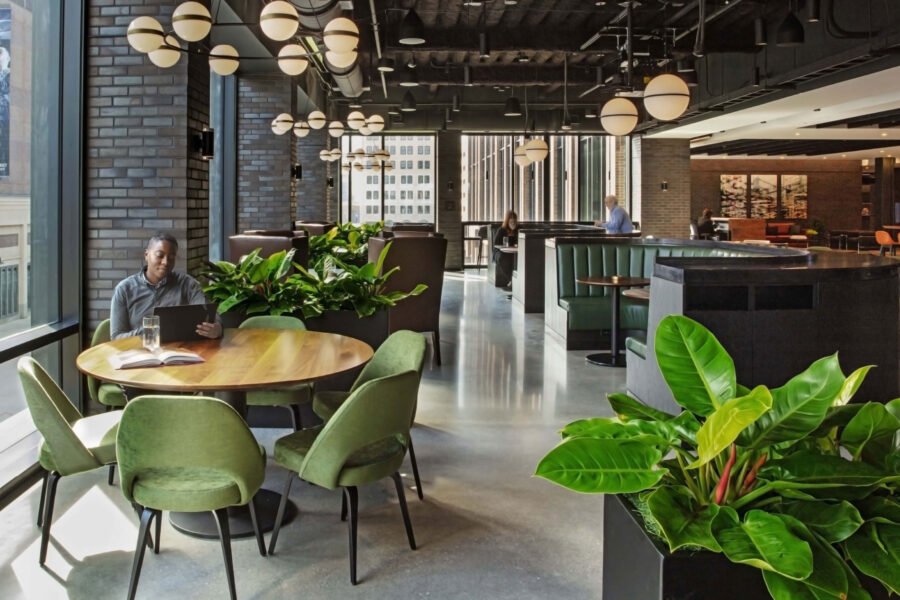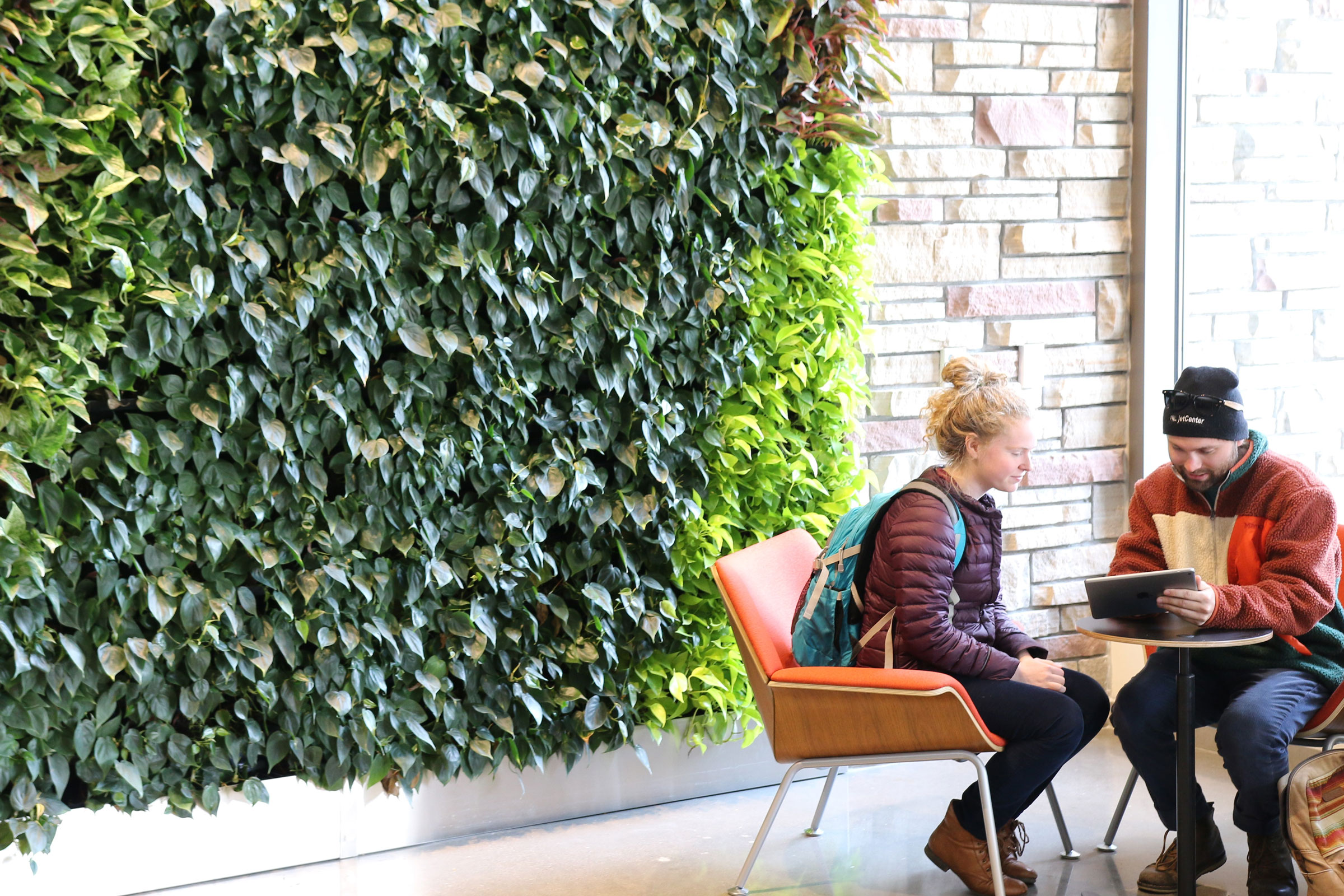Story at a glance:
- Greening a commercial space can be done on virtually any budget.
- First impressions are important when making a space greener and cleaner.
- How a space looks and feels, plays an intricate role in the overall brand image
The people have spoken. North American consumers want to experience greener and cleaner spaces wherever they live, work, learn, and play. For business owners and designers, that could mean an off-cycle refresh of interior and exterior spaces. Whether starting from scratch, planning an interior and/or exterior facelift, or looking for a simple refresh there is a green design for “almost” any budget. Breaking down the components of creating greener and cleaner designs can help business owners and designers better understand the overall process and how it can fit into their budget.
Creating greener and cleaner spaces can be as simple as adding a few strategically placed plants and enhancing high-traffic/consumer-facing spaces with ambient scent. It can also be as grand as interior/exterior vertical green walls, biophilic design enhancements like natural rock areas and water features, and improved indoor air systems.
With so many design options and ever-changing trends it can be hard to know where to focus attention. These four steps help to break down the process of creating green and clean spaces and help guide business owners and designers toward a tangible and tactical plan for enhancing interior and exterior spaces.
1. Re-evaluate the Space

Photo courtesy of Ambius
First impressions can make or break a person’s perception of a space. Forbes estimates people can form a first impression in as little as seven seconds. That means that by the time someone walks from the parking lot to the entryway and customer-facing area they have most likely already formed an impression of that space.
For this reason business owners and designers should re-evaluate the space and make note of areas that could use a refresh. Areas to consider may include:
● Exterior landscaping
● Entryways
● Lobbies
● Reception desks
● Other front-of-house spaces
Questions to consider when evaluating these spaces may be:
● Do these areas give off a welcoming vibe?
● Does it paint the appropriate picture for the brand?
● Are there additional ways to enhance the current space?
By taking a moment to re-evaluate interior and exterior spaces and note any areas that could use improvement, business owners and designers can be one step closer to creating a refreshed green and clean space.
2. Define the Vibe

Photo courtesy of Ambius
After taking time to re-evaluate the space it’s time to define the vibe. The vibe, or how a space looks and feels, plays an intricate role in the overall brand image. In fact, according to a recent Ambius survey of 3,000 North American adults ranging in age from 18 to 77, 83% say vibes are very or moderately important to their overall enjoyment of a space, making vibes critical to the overall customer and brand experience.
Whether mapping out a new design or looking to refresh an old one, adding biophilic design enhancements is a good place to start. Biophilic design elements have been oƒviben a steady incline of popularity for commercial spaces, and for good reason. It’s an interest that transcends generations.
Nearly 70% of Ambius survey-takers believe biophilic design is an important element of a space. This is particularly relevant for those looking to attract a younger demographic, as 80% of millennials and 74% of Gen Z surveyed championed biophilic design. Gen X (ages 43 to 58) followed behind at 63% and Baby Boomers at 53%.
There’s a wide range of biophilic design elements that can be incorporated into commercial spaces, making it important for designers and business owners to “define the vibe” before beginning a new design or refresh. Some biophilic design enhancements may include, but are not limited to:
● Bringing in natural and local materials. This has benefits beyond biophilia-inspired interior landscaping; premium vibes can be created as well as tie a space to its locality.
● Introducing plants with a mixture of sizes, varieties, and layouts. This can help create nature in a space with meaningful, direct connections.
● Accentuating spaces with natural light. This can instantly brighten a space, or you may install full-spectrum lighting that mimics natural lighting conditions.
● Incorporating fresh and natural scents. This helps increase the sensory experience and create nature in a space with non-visual interactions.
As business owners and designers work to define the vibe, consider which specific biophilic design elements may help improve that space. Incorporating one or even multiple biophilic design elements into commercial spaces is a great way to instantly enhance the vibe.
3. Consult with a Biophilic Design Expert

Natural light and potted plants bring life to commercial spaces. Photo courtesy of Ambius
Once you’ve re-evaluated the space and identified its overall vibe, consider consulting with a biophilic design expert on how to best execute your vision. Biophilic design experts will be able to identify the right plants for your space, environment, and budget. With so many options, decision-makers will be able to hand-pick their favorites based on the expert’s top selections.
When starting a new build or renovation, stakeholders often have a lot of questions about the upkeep and maintenance of living plants and natural elements within their space. Consulting with biophilic design experts can help answer those questions and alleviate any concerns. Some questions may include:
● What interior landscape designs will bring my vision to life?
● Which plants are right for my lighting and environmental conditions?
● What steps are required for the maintenance/upkeep of my plants, and what are my options?
● How can I fit impactful plant designs into smaller spaces?
During the consultation not only will the expert help answer questions, they will also review key considerations and generate a detailed design plan tailored to the project’s budget and environmental conditions. A consultation with a biophilic design expert should include:
● A discussion of all potential influences on the specific design project, including brand identity, style, space, light and heat levels, and quantities.
● A review of all considerations like form, texture, color, scale, and function.
● Documenting measurements and light readings to determine the best planting schemes.
● The use of photo imaging to show you how our design will meet your business objectives.
No matter the size, shape, or environment, several biophilic design enhancements can be tailored to your specific space. Consulting with an expert like one at Ambius can help bring your vision to life with an actionable plan that meets all of your unique needs.
4. Secure Final Approvals
The new green and clean design, or redesign, is mapped out. Now what? Receiving final approvals from key decision-makers can be challenging. While commercial designers understand the wide array of benefits that result from green and clean designs, executive leaders and key decision-makers may not have that same vision. When presenting the project for approval, make note of how the project can help support sustainability efforts.
These efforts may include:
● Alternatives to common building problems. Plant displays can aid in space management by forming natural screens and partitions in open design plans.
● Reducing demand on the water supply. Rainwater can be collected from the roofs of commercial buildings and used to water plants. Similarly, gray water (water that’s already been used once) can be treated and recycled to water plants. Ambius design experts can also install water-efficient irrigation systems and select plants with low water requirements.
● Cooling. Plants can help cool the air around them through the process of evapotranspiration, and by shading in the case of large interior plants.
● Improvements in indoor air quality. Plants can reduce airborne dust levels, carbon dioxide levels, and those of pollutants like benzene and nitrogen dioxide.
● Noise reduction. Plants and their leaves can absorb, diffract, or reflect background noise, making the environment more comfortable for the occupants.
● Well-being improvements and alleviating Sick Building Syndrome (SBS). Studies have shown health complaints at work and symptoms associated with SBS can be dramatically reduced by the addition of plant displays and natural light.
Still not sold? In addition to the practical environmentally friendly benefits of adding biophilic design to spaces, there are many known health benefits. Research shows integrating biophilic design into indoor environments positively impacts building occupants in several ways:
● Reduced Sick Building Syndrome
● Improved health
● Increased mood and feeling of well-being
● Improved productivity
● Increased employee engagement
● Reduced stress levels
● Mental restoration and reduced fatigue
Businesses can reduce the negative impacts of sterile, lean commercial spaces and enhance their environments by integrating a variety of biophilic features like green walls, plants, natural woods or stone, and fresh scents that mimic the natural world. These biophilic design elements effectively create a positive response as if people were exposed to the natural stimuli in real life.
The first step toward reaping the benefits of biophilic design enhancements is to re-evaluate the design space. Once the space is mapped out, define the overall vibe for that unique space. Next, consult with dedicated biophilic design experts to generate an actionable plan, and then sell those benefits to the executive leaders and key decision-makers for final sign-off. Once the plan is in place designers will have a step-by-step guide to turn their visionary concept into an actionable design reality.


